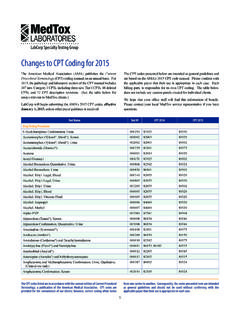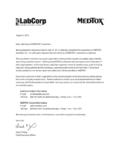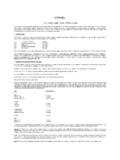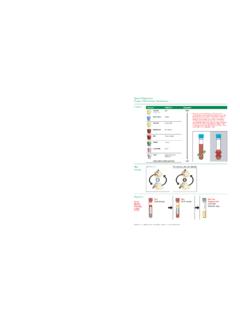Transcription of PROFILE -V MEDTOXScan Drugs of Abuse Test …
1 Page 1 of 12 PROFILE -V MEDTOXScan Drugs of Abuse Test system PACKAGE insert 1. INTENDED USE The PROFILE -V MEDTOXScan Drugs of Abuse Test system consists of the PROFILE -V MEDTOXScan Test Devices and the MEDTOXScan Reader. The PROFILE -V MEDTOXScan Test Devices are one-step immunochromatographic tests for the rapid, qualitative detection of one or more of the following in human urine: Amphetamine, Barbiturates, Benzodiazepines, Buprenorphine, Cocaine, Methadone, Methamphetamine, Opiates, Oxycodone, Phencyclidine, Propoxyphene, THC (Cannabinoids) and Tricyclic Antidepressants or their metabolites. The PROFILE -V MEDTOXScan Test Devices can only be used with the MEDTOXScan Reader. The MEDTOXScan Reader is an instrument used to interpret and report the results of the PROFILE -V MEDTOXScan Test Device.
2 The PROFILE -V MEDTOXScan Test Devices cannot be visually read. The PROFILE -V MEDTOXScan Drugs of Abuse Test system is for in vitro diagnostic use and is intended for prescription use only. It is not intended for use in point-of-care settings. The PROFILE -V MEDTOXScan Drugs of Abuse Test system detects drug classes at the following cutoff concentrations: AMP Amphetamine (d-Amphetamine) 500 ng/mL OPI Opiates (Morphine) 100 ng/mL or 2000 ng/mL BAR Barbiturates (Butalbital) 200 ng/mL BZO Benzodiazepines (Nordiazepam) 150 ng/mL OXY Oxycodone (Oxycodone) 100 ng/mL BUP Buprenorphine (Buprenorphine) 10 ng/mL PCP Phencyclidine (Phencyclidine) 25 ng/mL COC Cocaine (Benzoylecgonine) 150 ng/mL PPX Propoxyphene (Norpropoxyphene) 300 ng/mL MAMP Methamphetamine (d-Methamphetamine) 500 ng/mL THC Cannabinoids (11-nor-9-carboxy- 9-THC) 50 ng/mL MTD Methadone (Methadone) 200 ng/mL TCA Tricyclic Antidepressants (Desipramine) 300 ng/mL Configurations of the PROFILE -V MEDTOXScan Test Devices may consist of any combination of the above listed drug analytes.
3 Test Devices will have an opiate cutoff of either 100 ng/mL or 2000 ng/mL. Refer to specific product labeling for the combination of drug tests included on that test device. THE PROFILE -V MEDTOXScan Drugs OF Abuse TEST system PROVIDES ONLY A PRELIMINARY ANALYTICAL TEST RESULT. A MORE SPECIFIC ALTERNATE CHEMICAL METHOD MUST BE USED IN ORDER TO OBTAIN A CONFIRMED ANALYTICAL RESULT. GAS CHROMATOGRAPHY / MASS SPECTROMETRY (GC/MS), HIGH PERFORMANCE LIQUID CHROMATOGRAPHY (HPLC) OR LIQUID CHROMATOGRAPHY / TANDEM MASS SPECTROMETRY (LC/MS/MS) ARE THE PREFERRED CONFIRMATORY METHODS. CLINICAL CONSIDERATION AND PROFESSIONAL JUDGMENT SHOULD BE APPLIED TO ANY DRUG OF Abuse TEST RESULT, PARTICULARLY WHEN PRELIMINARY POSITIVE RESULTS ARE OBTAINED. The MEDTOXScan Reader includes a Positive QC Test Device, a Negative QC Test Device and a Cleaning Cassette.
4 The MEDTOXScan Positive and Negative QC Test Devices are intended to detect errors associated with the MEDTOXScan Reader and a contaminated contact imaging sensor (CIS), and to verify that the CIS cleaning procedure using the MEDTOXScan Cleaning Cassette effectively removed any contamination. 2. SUMMARY AND EXPLANATION OF THE TEST Qualitative PROFILE -V MEDTOXScan Test Devices utilize a one-step, solid-phase immunoassay technology. The PROFILE -V MEDTOXScan Drugs of Abuse Test system includes the MEDTOXScan Reader for a convenient automated result. This test system may be used to screen urine samples for one or more of the following drug classes prior to confirmatory testing: The amphetamines are a group of Drugs that are central nervous system stimulants. This group includes amphetamine and methamphetamine.
5 Amphetamine (d-amphetamine) is detected on the Test Device only at the (AMP) position, methamphetamine (MAMP) is detected at the (MAMP) position. Barbiturates (BAR) are a group of structurally related prescription Drugs that are used to reduce restlessness and emotional tension, induce sleep and to treat certain convulsive disorders. Benzodiazepines (BZO), a group of structurally related central nervous system depressants, are primarily used to reduce anxiety and induce sleep. Buprenorphine (BUP) is a potent analgesic often used in the treatment of opiate abusers. Cocaine (COC) is a central nervous system stimulant. Its primary metabolite is benzoylecgonine. Methadone (MTD) is a synthetic opioid used clinically as a maintenance drug for opiate abusers and for pain management. Opiates (OPI) are a class of natural and semi-synthetic sedative narcotic Drugs that include morphine, codeine and heroin.
6 Oxycodone (OXY) (Oxycontin , Percodan, Percocet) is a semi synthetic narcotic analgesic that is prescribed for moderately severe pain. It is available in both standard and sustained release oral formulations. Oxycodone is metabolized to Oxymorphone and Noroxycodone. Phencyclidine (PCP) is a hallucinogenic drug. Propoxyphene (PPX) is a narcotic analgesic. Its primary metabolite is Tricyclic Antidepressants (TCA) are a group of structurally related prescription Drugs that are used to manage depression. Marijuana (THC) is a hallucinogenic drug derived from the hemp plant. Marijuana contains a number of active ingredients collectively known as Cannabinoids. Many factors influence the length of time required for Drugs to be metabolized and excreted in the urine. A variety of factors influence the time period during which drug metabolites are detected in urine.
7 These include the rate of urine production, the volume of fluid consumption, the amount of drug taken, the urine pH, and the length of time over which drug was consumed. Drinking large volumes of liquid or using diuretics to increase urine volume will lower the drug concentration in the urine and may decrease the detection period. Lower detection levels may increase the detection time window. Although the detection period for these Drugs varies widely depending upon the compound taken, dose and route of administration and individual rates of metabolism, some general times have been established and are listed Page 2 of 12 Drug Detection Period Amphetamine Acid Conditions Alkaline Condition 1-3 days 3-10 days Barbiturates Short-Acting Long-Acting Up to 6 days Up to 16 days Benzodiazepines 1-12 days Buprenorphine up to 3 days Cocaine metabolite Up to 5 days 1 to 3 days typical Methadone 1-3 days Methamphetamine Acid Conditions Alkaline Conditions 1-3 days 3-10 days Drug Detection Period Opiates Heroin Morphine Codeine 1 day 1-3 days 1-3 days Oxycodone 1-3 days PCP Single Use Chronic Use 1-8 days Up to 4 weeks Propoxyphene Up to 1 week THC Single Use Chronic Use 1-7 days Less than 30 days typical Tricyclic Antidepressants 1-7 days 3.
8 PRINCIPLES OF THE PROCEDURE The PROFILE -V MEDTOXScan Drugs of Abuse Test system includes the one-step, competitive, membrane-based immunochromatographic PROFILE -V MEDTOXScan Test Device and the MEDTOXScan Reader, which interprets and reports the test results automatically. A single urine sample can be evaluated for the presence of each of the classes of Drugs specified in a single PROFILE -V MEDTOXScan Test Device. The PROFILE -V MEDTOXScan Test Device includes antibody-colloidal gold, drug-conjugates and a control line. ANTIBODY-COLLOIDAL GOLD Mouse monoclonal antibodies were developed that bind specifically to the drug class being tested. The individual monoclonal antibodies were adsorbed to colloidal gold and dried onto the test device. DRUG-CONJUGATES Drugs from each class to be tested were individually conjugated to bovine serum albumin (BSA) or IgG.
9 Each drug conjugate is immobilized on a test line at a designated position on the membrane strip. CONTROL LINE Each test strip has anti-mouse antibody immobilized at the Control position of the membrane strip. The anti-mouse antibody will bind excess antibody-colloidal gold, indicating that the reagents are working properly. When the urine sample is placed in the sample well of a test strip, the dried antibody-colloidal gold on the sample pad dissolves and the urine wicks up the white strips carrying the reddish-purple antibody-colloidal gold with it. The PROFILE -V MEDTOXScan Drugs of Abuse Test system will detect specific classes of Drugs in urine because drug(s) in the urine and the drug(s) conjugated to the protein compete to bind to the antibody-colloidal gold. A test line will form when drug in the sample is below the detection threshold (negative result).
10 The MEDTOXScan Reader scans the test device and utilizes a contact imaging sensor (CIS) to capture relative line intensities. Software algorithms and barcodes are used to identify the test device, the drug tests associated with the test device and whether the presence or absence of a line is associated with a negative or positive result, respectively. The results of the scans are displayed on the MEDTOXScan Reader screen or, optionally, can be printed. Negative Samples When no drug(s) is present in the urine sample, the reddish purple antibody-colloidal gold solutions migrate along the strip and bind to the respective drug conjugate(s) immobilized on the membrane. Each strip has up to 4 drug test lines. The binding of the antibody-colloidal gold to the drug conjugate generates a line at the corresponding test position on the strip.





